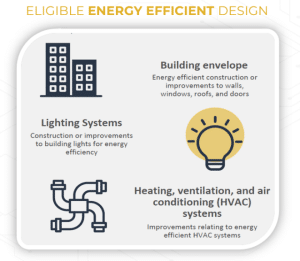Discover how green building cash incentives for A&E firms can drive significant cost savings in 2024 and beyond. As climate change and rising energy costs challenge businesses, sustainable solutions like the Section 179D deduction offer crucial financial incentives for energy-efficient improvements in commercial buildings.
Green Building Cash Incentives for A&E Firms
By Alexis Martin and Rachel Lindblade.
As the world confronts the urgent challenges posed by climate change and rising energy costs, businesses are increasingly seeking sustainable solutions to enhance operational efficiency. Among the available strategies, the Section 179D deduction emerges as a critical financial incentive for investing in energy-efficient improvements to commercial buildings. This provision of the Internal Revenue Code not only promotes sustainable practices but also delivers substantial tax savings, enabling organizations to offset costs associated with upgrading to greener technologies.
The United States is actively addressing climate change through significant measures to reduce greenhouse gas emissions and promote sustainable practices. One of the most impactful initiatives is the Inflation Reduction Act (IRA), which provides substantial tax incentives for clean energy investments. This legislation supports renewable energy tax credits, as well as investment deductions for efficiency improvements, encouraging both businesses and consumers to adopt greener technologies.
WHY IS THE 179D A GREAT INCENTIVE TO PROMOTE GREEN BUILDINGS?
The IRA significantly enhances clean energy investment and mitigates climate change through improved tax incentives. A standout feature of this legislation is the expansion of IRC Section 179D, which provides tax deductions for energy-efficient improvements in commercial buildings. The core principle of Section 179D is to incentivize investment in energy-efficient technologies and design, mainly in the Building Envelope and Systems (HVAC and Lighting) design, thereby promoting resource efficiency and sustainability.
With the IRA, the deduction allows commercial property owners and design professionals to deduct up to $5.36 per square foot in 2023, and up to $5.65 for 2024 for qualifying energy-efficient upgrades, a significant increase from the maximum $1.88 per square foot in 2022. This significant financial incentive encourages businesses to make capital investments that reduce energy consumption. Notably, the IRA has made it easier for businesses to qualify by lowering the required increase in energy efficiency from 50% to just 25% of the 2007 standards of the American Society of Heating, Refrigeration, and Air-Conditioning Engineers (ASHRAE). This shift aims to broaden participation and drive a larger number of commercial building upgrades, effectively aligning financial incentives with essential environmental goals.
Furthermore, the deduction’s structure facilitates immediate tax savings, which is increasingly vital as businesses face rising operational costs and fluctuating energy prices. By offsetting the initial costs of adopting energy-efficient technologies, the Section 179D deduction plays a crucial role in supporting businesses in their quest for sustainability while also contributing to a greener economy.
HOW CAN A&E FIRMS BENEFIT FROM THE 179D DEDUCTION?
Architecture, Engineering, and Construction firms stand to gain significantly from the Section 179D deduction, particularly when involved in the design and construction of energy-efficient buildings. Notably, the revised legislation allows tax-exempt entities (Government, Higher Education, K-12, Religious, Non-profits, etc.) to allocate the deduction to the primary designer responsible for energy-efficient improvements, unlocking previously inaccessible benefits to Architects and Engineering firms.
For-profit building owners who invest in qualifying energy-efficient upgrades can also claim the deduction, provided they meet specific criteria. The financial implications can be substantial. This tax incentive not only supports the immediate economic health of firms but also enhances their competitive edge in the growing market for sustainable building solutions.
By integrating energy-efficient designs into their projects, architecture and engineering firms can not only improve their bottom line but also demonstrate a commitment to sustainability. This proactive approach can attract environmentally conscious clients, further differentiating these firms in a competitive landscape.
WHY IS NOW THE RIGHT TIME TO EXPLORE THIS OPPORTUNITY?
With building owners and organizations facing increasing operational and construction costs and spikes in taxes due to 174 amortization requirements, A&E firms should strongly consider the 179D Deduction this year. Here are key points to note:
- Increased Deduction Amount: The deduction amount has nearly tripled for 2023 and 2024 compared to previous years. Smaller projects, previously deemed not worth the effort, should now be reconsidered for this deduction.
- Expanded Eligibility: Previously, only government buildings could allocate this deduction. Now, in 2023 and 2024, nonprofit organizations can also benefit. This expansion allows A&E firms to leverage the deduction for a wider range of projects, including schools, higher education institutions, religious institutions, and affordable housing.
- Waived PW&A Requirements: Prevailing Wage and Apprenticeship (PW&A) requirements are waived for projects that began before January 29th, 2023. Future projects will need to meet these requirements to maximize the deduction benefits.
- Energy Efficiency Standards: The qualification criteria for energy efficiency improvements are currently based on the 2007 ASHRAE standards, which are relatively easy to meet for new construction and renovations. However, after the 2026 tax year, the standards will shift to the 2019 ASHRAE guidelines, making it more challenging to qualify for the full deduction amount.
Claiming the Section 179D deduction involves several key steps. First, businesses need to identify eligible projects with qualifying improvements that meet the deduction criteria. Next, they must obtain necessary certifications from qualified professionals to confirm compliance with energy savings standards. Additionally, businesses must gather documentation demonstrating compliance and report it to tax form 7205.
Engaging with EPSA USA, which has long-standing expertise helping A&E firms with credits and incentives, can ensure proper documentation, optimized savings, and streamline the claiming process alongside your CPA firms.
To request an assessment of your 179D Deduction, please contact Alexis Martin, CEO, EPSA USA
[email protected] / +1 (917) 495 5746











